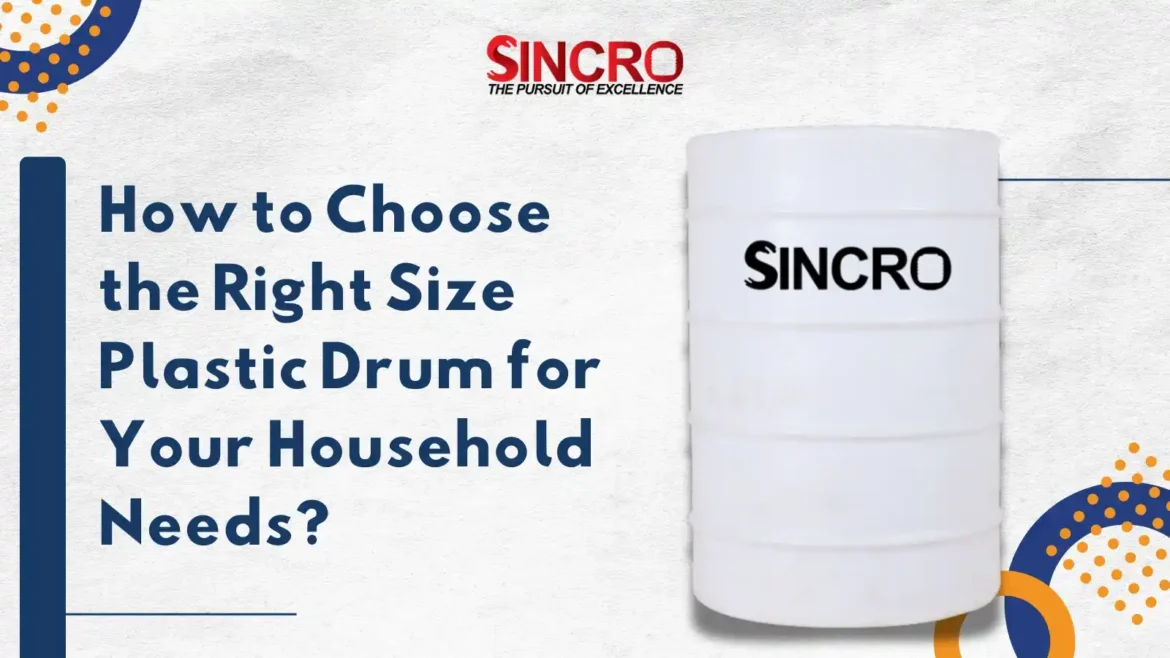When storing water at home, it is important to choose the correct plastic drum for water storage. There are many reasons you may be looking for a plastic drum, like you need a reliable source consistently, as a backup in case of an emergency, or just to clean your things and garden. The drum makes a big difference. There are all kinds of shapes and sizes to choose from, anyway, so it can be hard to determine what the best fit is for you and your household.
This blog will help you determine what plastic household drum to choose when you consider your reasons for storing water, the available space, and how credible the plastic drum manufacturer is.
Why Does Choosing the Right Size Matter?
The size of your water storage tank is important. If it’s too small, you will be constantly replenishing your storage tank. If it is too big, it will take up unnecessary space and be cumbersome to handle.
If you can choose the size that meets your needs, you will avoid the downsides of small and large size storage tanks, and you’ll enjoy the benefits of always having clean water available.
But it is more than just convenience, effective water storage is an important aspect of water conservation and emergency preparedness.
1. Evaluate Your Water Consumption
First of all, determine approximately how much water your household uses daily. In general, a one-person household needs around 100 to 150 litres of backup water for those situations of drinking, cooking, washing, and bathing.
Now, if you are only backing up water for limited purposes like kitchen use or flushing, your needs would be substantially less. Determine how many people are in your household, how often you might use the stored water, and what your intended uses are.
Doing this kind of simple determination should give you a basic sense of what size drum could be useful for what may not run out too quickly, and should not be unused for long periods.
2. Determine the Usage Purpose
The intended use of the water drum plays a major role in deciding its size and design. For example, if you’re using it for drinking and cooking, opt for a food-grade plastic drum that’s hygienic and easy to clean.
For general cleaning, gardening, or flushing toilets, a standard plastic drum may suffice. If you aim to store water during municipal supply shortages or for emergencies, you may want to consider buying more than one drum to ensure backup capacity.
3. Consider Available Space
Space constraints are a common issue in urban homes, especially in cities like Mumbai. Before selecting a drum, measure the space where it will be kept, whether it’s a kitchen corner, balcony, utility room, or terrace.
Drums with a taller, narrow design are more suitable for compact areas, while wider drums work well in open or outdoor spaces. Choosing the right drum shape and size according to your space ensures safety, convenience, and easy access.
4. Material and Build Quality
When choosing a water drum, always prioritize quality. Look for drums made from virgin, UV-stabilized plastic that can withstand exposure to sunlight and harsh conditions. This is especially important in coastal cities like Mumbai, where weather and humidity levels can affect storage containers.
Reputable manufacturers like Sincro provide high-quality, durable, and hygienic plastic household drums that are specifically designed for Indian households. Their Sincro household drums are known for being strong, easy to handle, and resistant to leakage and cracks.
Final Thoughts
Selecting the right plastic water drum is not just a matter of size; it’s about safety, efficiency, and long-term usability. With a thoughtful approach and quality products from Sincro, you can be sure of reliable water storage that fits your lifestyle and your home.
Sincro’s drums are made from high-grade plastic, UV-stabilized for weather protection, and available in easy-to-handle sizes. Their thoughtful design ensures long-term durability, making them the preferred choice for homes across India.
Explore their full range of household drums and contact them to choose the size that suits your home best.
Frequently Asked Questions
1. What are the different sizes of plastic drums?
At Sincro, plastic household drums are available in 100 litres, 150 litres, and 225 litres. These sizes are ideal for domestic water storage, balancing compact design with ample capacity for everyday household needs.
2. What is the standard drum size?
The most common standard size for general-purpose plastic drums is around 200 litres. This size is widely used for both household and light industrial storage, offering a practical balance between capacity and portability.
3. How do you measure drum size?
Drum size is measured by its storage capacity in litres, calculated based on internal volume. Dimensions like height and diameter also help determine the overall volume and fit for storage spaces.
4. What are the standard sizes of chemical drums?
Sincro offers chemical drums ranging from 200 litres to 10,000 litres. These industrial-grade drums are designed for safe and efficient storage of large volumes of chemicals, oils, or other industrial liquids.





